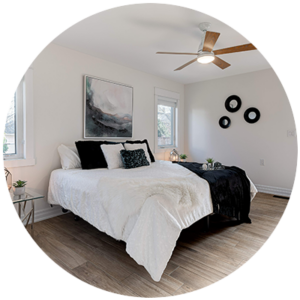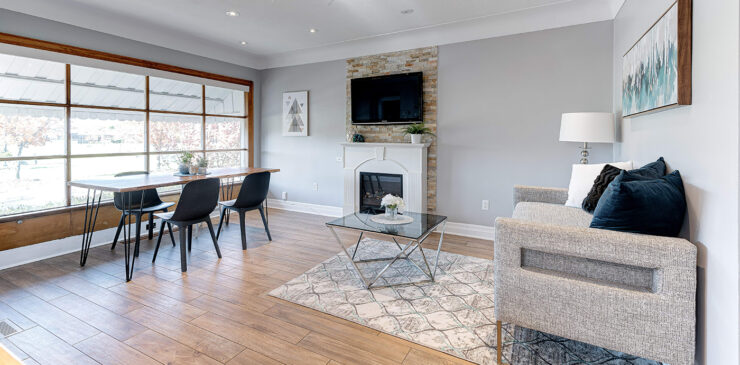When Mike and Courtney purchased their Hamilton Ontario home, it had hardwood and vinyl floors. The weight of Mike’s power wheelchair caused the uneven hardwood floor in the living room to creak and snap as he drove through the house. The hallways and bedrooms had vinyl floors and Mike says it was good for about 2-3 years before it started to peel up and crack. This was especially evident in the areas where he turned or spun around. Mike told me “The torque of my big wheels really chewed it up over time; literally breaking the floor into pieces.”
 The flooring in the house did not properly support Mike’s power chair. They needed to make a change but they had trouble finding useful information on the type of residential flooring that could withstand the daily grind of Mike’s power wheelchair. You could say they were floored at the lack of information available! After considerable research, they chose a porcelain tile that resembled wood planks. It is the perfect balance of aesthetics and performance and a great flooring solution.
The flooring in the house did not properly support Mike’s power chair. They needed to make a change but they had trouble finding useful information on the type of residential flooring that could withstand the daily grind of Mike’s power wheelchair. You could say they were floored at the lack of information available! After considerable research, they chose a porcelain tile that resembled wood planks. It is the perfect balance of aesthetics and performance and a great flooring solution.
But what if you wanted to consider other flooring options?
I reached out to Pat Acquisto, a home modification expert, and Susan Drew, a flooring company representative, to ask for their advice.
Pat Acquisto runs Pro Accessibility, a construction and project management firm that designs and builds safe, accessible, and inclusive environments. He has worked in the construction industry since 2001 and has focused on accessible home modifications since 2013.Susan Drew works at Altro, a company that has been at the forefront of flooring innovation for over 100 years. Susan focuses on Altro’s Senior Living division.
Sturdy Subfloor
What you can’t see matters.
In residential homes, the subfloor is the layer below the floor and is usually a type of plywood. In condominiums, there is usually concrete below the floor.
Pat says “Good flooring starts with a sturdy subfloor.”Whether your floor needs to be level, or sloping towards a bathroom floor drain, the subfloor must be even and not have too much flexibility, otherwise it may lead to gaps, cracks and possible breakage.
The original subfloor in Mike and Courtney’s house was insufficient and not installed properly which contributed to their flooring problems.
Whatever flooring you choose, start with a proper subfloor.
Smooth Transitions
Most homes have a variety of flooring surfaces. This gives the home character and helps define different areas. To minimize tripping hazards or mobility concerns, Susan says “It is essential to understand where transitions connect, how they connect and the height differences that occur.” And she goes on to say if “attention is not taken around transitions, it can be a huge safety concern.” Pat agrees: “When designing for wheelchair access you always want to avoid or reduce any floor height differences.”
Mike and Courtney know all about the importance of smooth transitions. They had 4 different types of flooring, all at different levels. “The thresholds were not smooth. To go into the kitchen – bump, to go into the bathroom – bump.” Once the new flooring was installed there were no thresholds and no transitions. The floor was one smooth level.
Professionally Installed
When modifying your home, it’s important to use professionals who have experience and understanding of accessibility and a proven track record of successfully working with people with disabilities.
Choosing the right type of flooring product and having it installed is no different. Ask professionals for advice and ask experienced contractors to install your floor. Pat told me that his company handles flooring selection and installation in-house. This ensures it’s done properly. He says “Seamless, sturdy surfaces are what we are looking to achieve” and “Our staff is trained to provide options that will meet our customers’ needs based on their disability, location and budget.” Susan adds that flooring needs to be “installed with the appropriate adhesive and proper care and attention.”
 “When modifying your home, it’s important to use professionals who have experience and understanding of accessibility and a proven track record of successfully working with people with disabilities.”
“When modifying your home, it’s important to use professionals who have experience and understanding of accessibility and a proven track record of successfully working with people with disabilities.”
Porcelain and Ceramic Flooring
Mike and Courtney love their porcelain floors from Savoia Italia. The tiles are scratch-proof and waterproof so they are ideal for wheelchair users. Wet wheels are not a concern. The tiles are imported from Italy and sold by flooring companies in Ontario.
Non-slip porcelain flooring is Pat’s first choice. However, if you choose to go with ceramic floor tiles he says to make sure they are at least 3/8” thick and non-slip.
When it comes to choosing the grout colour for tile floors, Mike recommends a dark colour to help hide the dirt. Pat says to have the tiles and grout sealed to help protect them and keep them looking new.
 Vinyl Flooring
Vinyl Flooring
Vinyl flooring products have improved significantly over the years, becoming popular in residential homes. Both Susan and Pat are proponents of vinyl flooring.
Altro, Susan’s company, sells several resilient vinyl sheet flooring solutions. Susan told me, “Traditionally, aesthetics has been the most important consideration in residential applications.” However, she says durability and performance are also important when it comes to mobility, safety, and accessibility.
Pat says that luxury non-slip vinyl plank flooring meets many of his customers’ requirements. It’s simple to handle and install, usually waterproof, and low-maintenance.
Wood Flooring
Hardwood floors are very popular too. Pat recommends ¾” oak hardwood or engineered hardwood. He advises clients to avoid softer woods like pine. And he cautions that water (from wet wheels) can damage hardwood flooring if it’s not wiped up quickly.
Some condo buildings may have rules around wood and tile flooring, mainly because of sound transmission between floors, so check with the property manager first.
Budget
When it comes to supplying and installing flooring there are too many products and cost variables for me to provide an accurate budget in this article. I encourage you to talk with a flooring expert, and a professional installer to determine a budget.
No one wants their floor to crack under pressure, so take the time to give it the support it needs with a sturdy subfloor. Ensure you’ve got smooth transitions from room to room, select a flooring product that is strong and non-slip, and have it professionally installed.
 Jeffrey Kerr
Jeffrey Kerr
Broker, Barrier Free Real Estate Specialist RE/MAX Prime Properties Unique Group, Brokerage






